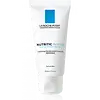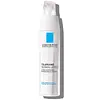La Roche-Posay Nutritic Intense Cream Versus La Roche-Posay Toleriane Dermallergo Ultra Soothing Repair Moisturizer
What's inside
What's inside
 Key Ingredients
Key Ingredients

 Benefits
Benefits

 Concerns
Concerns

 Ingredients Side-by-side
Ingredients Side-by-side

Water
Skin ConditioningGlycerin
HumectantCetearyl Alcohol
EmollientIsohexadecane
EmollientGlyceryl Stearate
EmollientCyclohexasiloxane
EmollientCaprylic/Capric/Succinic Triglyceride
EmollientPetrolatum
EmollientButyrospermum Parkii Butter
Skin ConditioningPEG-100 Stearate
Glycine Soja Oil
EmollientCeteareth-20
CleansingParaffinum Liquidum
EmollientDimethicone
EmollientBis-PEG-18 Methyl Ether Dimethyl Silane
EmollientSynthetic Wax
AbrasiveEthylhexyl Palmitate
EmollientBehenyl Alcohol
EmollientAluminum Starch Octenylsuccinate
AbsorbentHexyldecanol
EmollientHexyldecyl Laurate
EmollientCera Microcristallina
Emulsion StabilisingNiacinamide
SmoothingParaffin
PerfumingGlyceryl Stearate Citrate
EmollientDimethiconol
EmollientMyristyl Malate Phosphonic Acid
Skin ConditioningAmmonium Polyacryloyldimethyl Taurate
Emulsion StabilisingDisodium EDTA
Disodium Ethylene Dicocamide PEG-15 Disulfate
CleansingCaprylyl Glycol
EmollientXanthan Gum
EmulsifyingAcrylates Copolymer
Tocopherol
AntioxidantPhenoxyethanol
PreservativeParfum
MaskingCitric Acid
BufferingPolyphosphorylcholine Glycol Acrylate
Chlorhexidine Digluconate
AntimicrobialWater, Glycerin, Cetearyl Alcohol, Isohexadecane, Glyceryl Stearate, Cyclohexasiloxane, Caprylic/Capric/Succinic Triglyceride, Petrolatum, Butyrospermum Parkii Butter, PEG-100 Stearate, Glycine Soja Oil, Ceteareth-20, Paraffinum Liquidum, Dimethicone, Bis-PEG-18 Methyl Ether Dimethyl Silane, Synthetic Wax, Ethylhexyl Palmitate, Behenyl Alcohol, Aluminum Starch Octenylsuccinate, Hexyldecanol, Hexyldecyl Laurate, Cera Microcristallina, Niacinamide, Paraffin, Glyceryl Stearate Citrate, Dimethiconol, Myristyl Malate Phosphonic Acid, Ammonium Polyacryloyldimethyl Taurate, Disodium EDTA, Disodium Ethylene Dicocamide PEG-15 Disulfate, Caprylyl Glycol, Xanthan Gum, Acrylates Copolymer, Tocopherol, Phenoxyethanol, Parfum, Citric Acid, Polyphosphorylcholine Glycol Acrylate, Chlorhexidine Digluconate
Water
Skin ConditioningIsocetyl Stearate
EmollientSqualane
EmollientButyrospermum Parkii Butter
Skin ConditioningDimethicone
EmollientGlycerin
HumectantZea Mays Starch
AbsorbentPentylene Glycol
Skin ConditioningButylene Glycol
HumectantGlyceryl Stearate
EmollientPEG-100 Stearate
Cetyl Alcohol
EmollientSalvia Miltiorrhiza Root Extract
Skin ConditioningDimethiconol
EmollientSodium Hydroxide
BufferingSphingomonas Ferment Extract
Skin ConditioningCaprylyl Glycol
EmollientCitric Acid
BufferingAcetyl Dipeptide-1 Cetyl Ester
Skin ConditioningAcrylates/C10-30 Alkyl Acrylate Crosspolymer
Emulsion StabilisingWater, Isocetyl Stearate, Squalane, Butyrospermum Parkii Butter, Dimethicone, Glycerin, Zea Mays Starch, Pentylene Glycol, Butylene Glycol, Glyceryl Stearate, PEG-100 Stearate, Cetyl Alcohol, Salvia Miltiorrhiza Root Extract, Dimethiconol, Sodium Hydroxide, Sphingomonas Ferment Extract, Caprylyl Glycol, Citric Acid, Acetyl Dipeptide-1 Cetyl Ester, Acrylates/C10-30 Alkyl Acrylate Crosspolymer
 Reviews
Reviews

Ingredients Explained
These ingredients are found in both products.
Ingredients higher up in an ingredient list are typically present in a larger amount.
This ingredient is also known as shea butter. It is an effective skin hydrator and emollient.
Emollients help soothe and soften your skin. It does this by creating a protective film on your skin. This barrier helps trap moisture and keeps your skin hydrated. Emollients may be effective at treating dry or itchy skin.
Shea butter is rich in antioxidants. Antioxidants help fight free-radicals, or molecules that may harm the body. It is also full of fatty acids including stearic acid and linoleic acid. These acids help replenish the skin and keep skin moisturized.
While Shea Butter has an SPF rating of about 3-4, it is not a sunscreen replacement.
Shea butter may not be fungal acne safe. We recommend speaking with a professional if you have any concerns.
Learn more about Butyrospermum Parkii ButterCaprylyl Glycol is a humectant and emollient, meaning it attracts and preserves moisture.
It is a common ingredient in many products, especially those designed to hydrate skin. The primary benefits are retaining moisture, skin softening, and promoting a healthy skin barrier.
Though Caprylyl Glycol is an alcohol derived from fatty acids, it is not the kind that can dry out skin.
This ingredient is also used as a preservative to extend the life of products. It has slight antimicrobial properties.
Learn more about Caprylyl GlycolCitric Acid is an alpha hydroxy acid (AHA) naturally found in citrus fruits like oranges, lemons, and limes.
Like other AHAs, citric acid can exfoliate skin by breaking down the bonds that hold dead skin cells together. This helps reveal smoother and brighter skin underneath.
However, this exfoliating effect only happens at high concentrations (20%) which can be hard to find in cosmetic products.
Due to this, citric acid is usually included in small amounts as a pH adjuster. This helps keep products slightly more acidic and compatible with skin's natural pH.
In skincare formulas, citric acid can:
While it can provide some skin benefits, research shows lactic acid and glycolic acid are generally more effective and less irritating exfoliants.
Most citric acid used in skincare today is made by fermenting sugars (usually from molasses). This synthetic version is identical to the natural citrus form but easier to stabilize and use in formulations.
Read more about some other popular AHA's here:
Learn more about Citric AcidDimethicone is a type of synthetic silicone created from natural materials such as quartz.
What it does:
Dimethicone comes in different viscosities:
Depending on the viscosity, dimethicone has different properties.
Ingredients lists don't always show which type is used, so we recommend reaching out to the brand if you have questions about the viscosity.
This ingredient is unlikely to cause irritation because it does not get absorbed into skin. However, people with silicone allergies should be careful about using this ingredient.
Note: Dimethicone may contribute to pilling. This is because it is not oil or water soluble, so pilling may occur when layered with products. When mixed with heavy oils in a formula, the outcome is also quite greasy.
Learn more about DimethiconeDimethiconol is a silicone that resembles the popular dimethicone. Like other silicones, it is an emollient. Emollients create a thin film on skin to prevent moisture from escaping.
This ingredient helps to create a silky texture and improve spreadability. Due to its high molecular weight and thickness, it is often combined with cyclopentasiloxane.
Glycerin is already naturally found in your skin. It helps moisturize and protect your skin.
A study from 2016 found glycerin to be more effective as a humectant than AHAs and hyaluronic acid.
As a humectant, it helps the skin stay hydrated by pulling moisture to your skin. The low molecular weight of glycerin allows it to pull moisture into the deeper layers of your skin.
Hydrated skin improves your skin barrier; Your skin barrier helps protect against irritants and bacteria.
Glycerin has also been found to have antimicrobial and antiviral properties. Due to these properties, glycerin is often used in wound and burn treatments.
In cosmetics, glycerin is usually derived from plants such as soybean or palm. However, it can also be sourced from animals, such as tallow or animal fat.
This ingredient is organic, colorless, odorless, and non-toxic.
Glycerin is the name for this ingredient in American English. British English uses Glycerol/Glycerine.
Learn more about GlycerinGlyceryl Stearate is a mix of glycerin and stearic acid.
It is used to stabilize the mixing of water and oil ingredients. By preventing these ingredients from separating, it can help elongate shelf life. It can also help thicken the product's texture.
As an emollient, it helps soften skin and supports barrier-replenishing ingredients.
In cosmetics, Glyceryl Stearate is often made from vegetable oils or synthetically produced.
This ingredient may not be fungal-acne safe
Fun fact: The human body also creates Glyceryl Stearate naturally.
Learn more about Glyceryl StearatePeg-100 Stearate is an emollient and emulsifier. As an emollient, it helps keep skin soft by trapping moisture in. On the other hand, emulsifiers help prevent oil and water from separating in a product.
PEGS are a hydrophilic polyether compound . There are 100 ethylene oxide monomers in Peg-100 Stearate. Peg-100 Stearate is polyethylene glycol ester of stearic acid.
Water. It's the most common cosmetic ingredient of all. You'll usually see it at the top of ingredient lists, meaning that it makes up the largest part of the product.
So why is it so popular? Water most often acts as a solvent - this means that it helps dissolve other ingredients into the formulation.
You'll also recognize water as that liquid we all need to stay alive. If you see this, drink a glass of water. Stay hydrated!
Learn more about Water